A standardised, high-security driving licence model will be introduced in the European Union over the period 2013–2033. This licence will be the size of a credit card. The changes being made to driving licences are based on the EU's Third Driving Licence Directive, which came into effect in 2006 and is binding for all Member States.
Current driving licence model introduced in April 2024
The appearance of the driving licence was updated at the beginning of April 2024 when the new driving licence model was introduced. The card got a new background printing pattern, and some of the security features also changed. The new card includes a transparent window with the licence holder’s facial photograph, for example.
For more information on different driving licence models and their security features, please see the EU website on driving licences (External link).
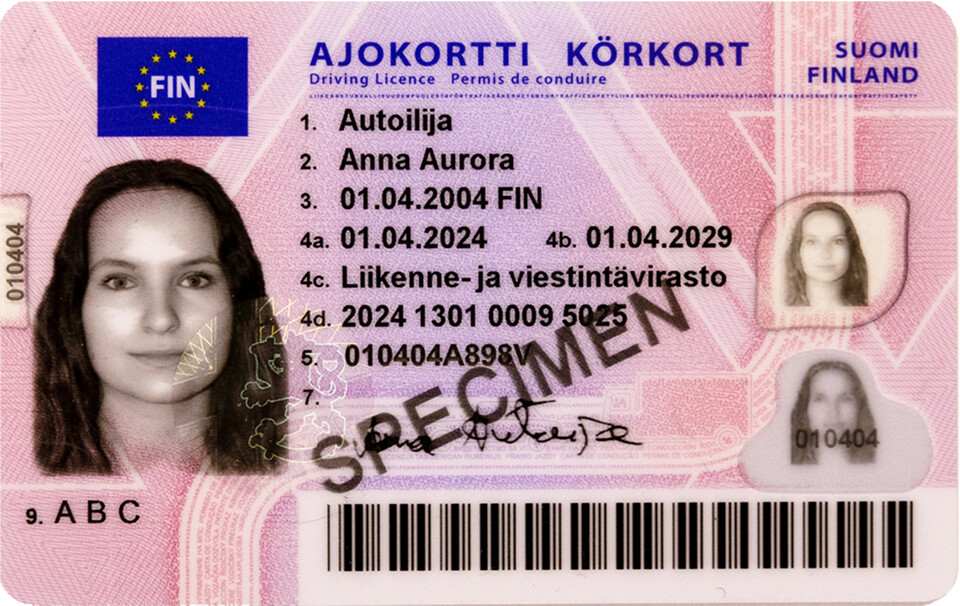
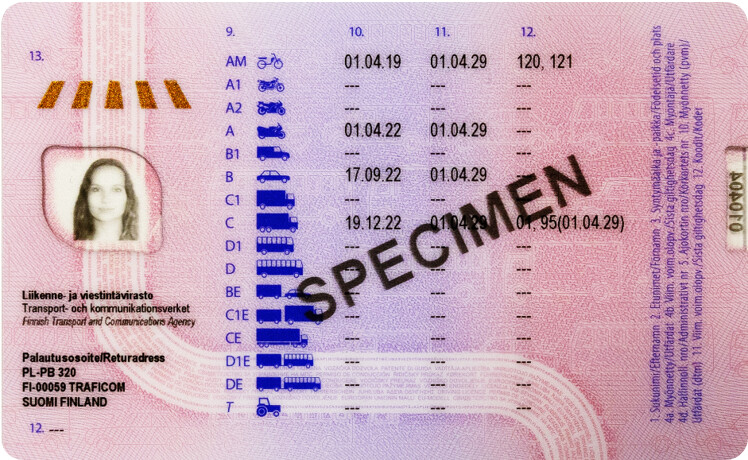
Previous driving licence model introduced in 2019
The appearance of the driving licence was previously updated in April 2019. The card got a new background printing pattern, and some of the security features changed. The raised engraving on the front side of the licence was changed so that it overlaps with the facial photograph, for example. On the back, the category LT was removed from the table of licence categories because it is no longer used. For more information on different driving licence models and their security features, please see the EU website on driving licences.


History of driving licences from 1972 to 2013
Centralised driving licence register established in 1972
The centralised registration of driving licences began at the beginning of July 1972. Registration sought to boost the effectiveness of driving licence control, eliminate the potential for forgery, create a framework for standardising driving licence practices, and widen the scope for conducting research and compiling statistics. By the end of 1972, almost 140,000 licences had been entered into the centralised driving licence register. At the end of 2014, the register held details for about 3.7 million licence holders.
The establishment of the centralised driving licence register was accompanied by a reclassification of driving licences. A pink cardboard licence was also introduced at this time under the Vienna Convention on Road Traffic.
Old cardboard driving licence

Two-phase driving licence
The two-phase driving licence system was introduced in Finland in October 1989. A holder's first class B driving licence (a driving licence for a passenger car) was valid for an initial period of two years (short-term driving licence). A course of further instruction was required to obtain a full licence, and this could be taken earliest six months after obtaining a short-term licence. From January 1996 to January 2013, you could not obtain a full licence until the six months preceding the expiry of your short-term licence.
New Driving Licence Decree and the driving licence as part of the road traffic information system
The driving licence register at the Motor Vehicle Registration Centre and the direct enquiry system introduced by the Police at the beginning of the 1980s were combined in October 1990 as part of the direct access road traffic information system administered by the Motor Vehicle Registration Centre.
A new plastic A7 security-printed driving licence was introduced at the same time. The procedure for issuing driving licences also changed. The police issued applicants with a driving licence permit, which was one of the requirements for issuing a driving licence. However, applicants only had the right to drive once the licence itself was issued. For short-term driving licences, the permit was issued when the driver began taking driving instruction. The biggest change was that driving examiner immediately issued a short-term licence to those who passed their driving examination, as long as they were in possession of a valid driving licence permit.
Front of A7 driving licence
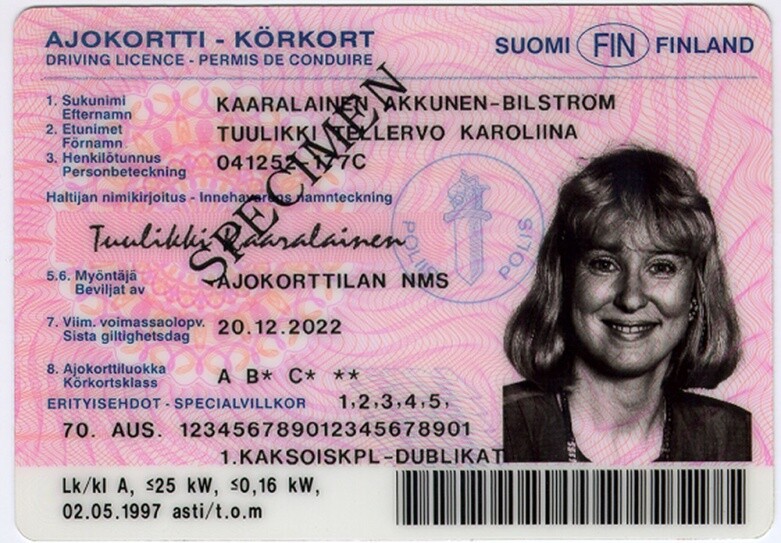
Reverse of A7 driving licence
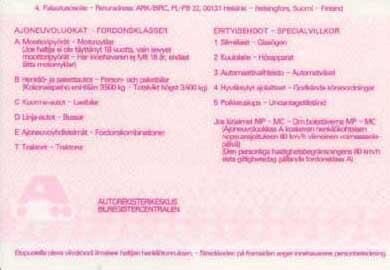
Changes introduced by the EU
By joining the EEC, Finland committed to bringing its legislation in line with the EC Driving Licence Directive by 1 July 1996. Finland joined the EU in January 1995. The directive also required the introduction of the EU driving licence, but Finland was given more time to implement the change (until the end of 1997).
The change resulted in two new driving licence categories: A1 and D1. Both restrictions and extensions were added to the right to drive a motorcycle (Category A), and these details had to be recorded in the licence. If a licence holder wished to exchange a foreign driving licence for a Finnish one without taking a test, the new licence also had to show the details of any licences issued in non-EU or non-EEC countries.
At the same time, new restrictions on the right to drive certain vehicle combinations were introduced for Category B licence holders. This change took effect from the beginning of 1997. However, if an application had been submitted before the end of 1996, Category B licence holders could be granted the right to drive a vehicle in Category BE ("small E2") without the need to take a driving examination or provide a medical certificate. More than 980,000 people applied for the "small E" driving licence, although only some of them required its entitlements.
EU driving licence introduced in January 1998
A new driving licence the size of a credit card (the EU driving licence) was introduced from the beginning of 1998. It contained information that had been lacking in earlier versions. The new details shown on the front of the licence are the holder's country of birth, the date of issue, and the licence number. The reverse side shows the driving licence categories, which are also displayed as images.
Another new feature is a start and end date for the right to drive each category of vehicle, and the potential for special conditions to be attached to each category. Some of the most common special conditions are glasses (01) and a duplicate of the driving licence (103).
The reverse side of the EU driving licence has space for any remarks by a recipient EU country in cases where the right to drive terminates in that country earlier than it does in Finland. There is also room on the licence for details of organ donation. Provision has also been made for a microprocessor, should one be required in the future.
Front of the credit card-size EU driving licence
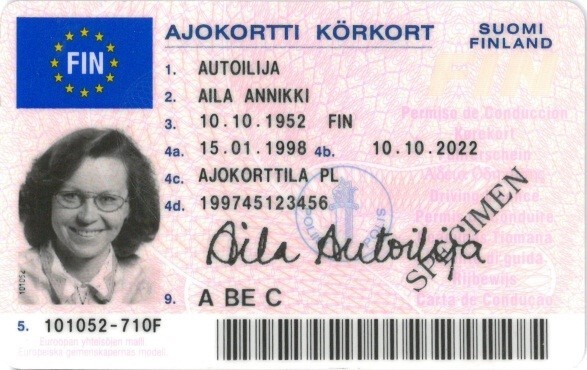
Reverse of the credit card-size driving licence
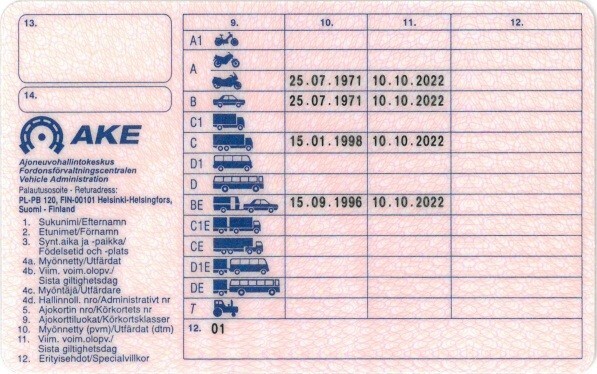
Moped licence introduced in 2000
A new driving licence category, Category M, was introduced at the beginning of 2000. It entitles the holder to drive mopeds and light quadricycles. Anyone born on or after 1 January 1985 will need a licence to drive a moped or at any age to drive a light quadricycle. The right to drive vehicles in Category M is included in the right to drive a motorcycle or car. In order to receive a moped licence, you had to be at least 15 years of age, have a driving licence permit, and have passed the theory test of your driving examination.
Front side of moped licence

Reverse of moped licence
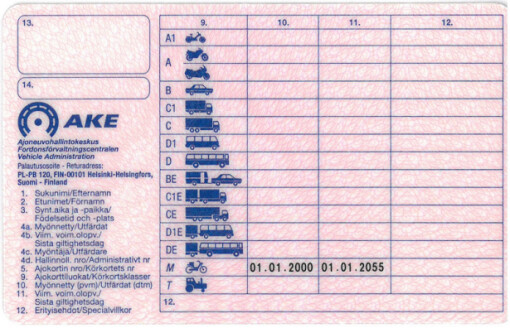
Changes to the driving licence as a result of EU enlargement in 2004
Ten new countries joined the European Union at the beginning of May 2004: Estonia, Latvia, Lithuania, Poland, Czech Republic, Slovakia, Hungary, Slovenia, Malta and Cyprus. As a result, the words for "driving licence" were also printed on the licence in the languages of the new Member States. The background was also improved to make the various words for "driving licence" stand out more clearly.
The text "FIN", which used to appear along the top right, was moved to bottom. On the front of the licence, an AKE logo colour-printed in OVI was added to the lower-right corner. In other respects, the background remained unchanged. The Ministry of Transport and Communications validated the new driving licence model on 12 January 2004.

Changes to the driving licence as a result of EU enlargement in 2007
Bulgaria and Romania joined the European Union on 1 January 2007. As a result, the words for "driving licence" were also printed on the licence in the official languages of these countries. The Ministry of Transport and Communications validated the new driving licence model on 1 February 2007.
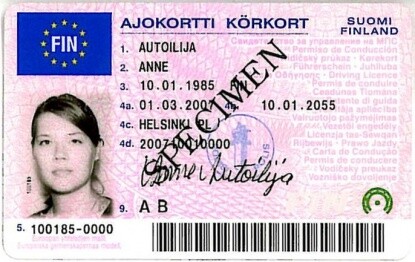
Changes to driving licence security features
The driving licence's security features were updated on 10 April 2010. The AKE logo colour-printed in OVI was replaced with a three-dimensional variable laser image (MLI). The variable laser image shows the holder's year of birth, the Trafi logo and the abbreviation "FIN", depending on the angle of view.
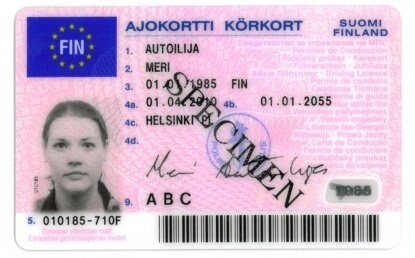
The driving licence model introduced in January 2013
A new driving licence model was introduced in Finland on 19 January 2013. The new model incorporates improved security features. For example, an OVI element has been added to the lower-right corner of the holder's photograph, and the variable element in the lower-right corner of the card now displays either the holder's photograph or date of birth. The card's background design has also been altered, and the words for "driving licence" have been added to the header in English and French.
When Croatia joined the European Union in June 2014, the Croatian term for "driving licence" was added to the background design on the front of the licence. At the same time, the f in Trafi's logo on the reverse of the licence was changed from a capital F to a lower-case f.
Front of driving licence
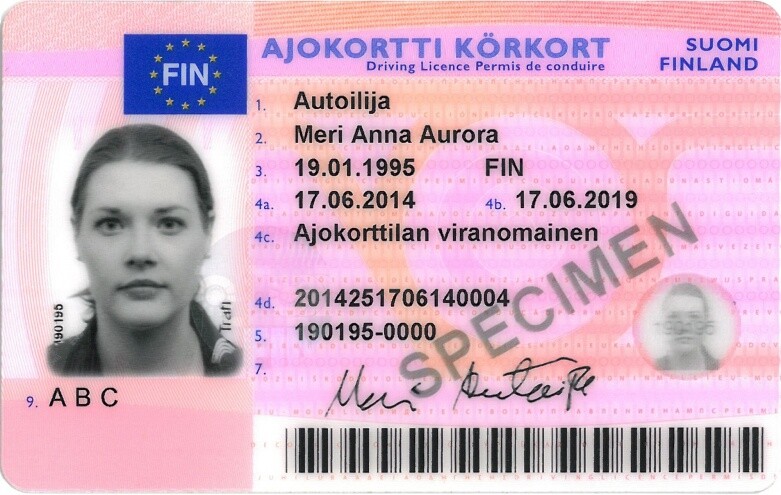
Reverse of driving licence
